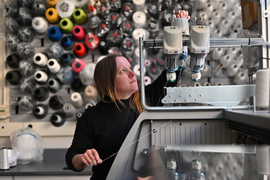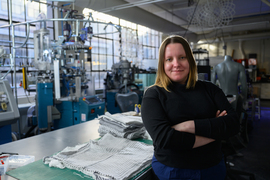Encouraged by her family, Lavender Tessmer explored various creative pursuits from a young age, particularly textiles, including knitting and crocheting. When she came to MIT, she figured that working with textiles would remain just a hobby; she never expected them to become integral to her career path.
However, when she interviewed for a research assistant position in Self Assembly Lab, it just so happened that the lab had recently received funding from the Advanced Functional Fabrics of America, one of the manufacturing institutes launched during the Obama administration, for a textile-based project.
Tessmer, now a fifth-year doctoral student in design and computation within the School of Architecture and Planning, took on the project, working with Skylar Tibbits, associate professor of design research, and Caitlin Muller, associate professor in building technology. “At MIT, my interest in textiles really exploded and became the center of everything,” Tessmer says.
While textiles may appear commonplace, the Covid-19 pandemic underscored the need for textile products in safeguarding our general health and safety, particularly through the filtration necessary for masks. Recognizing the importance of manufacturing capabilities for textiles, Tessmer’s research has focused on programming textiles with specific functional properties while also considering the feasibility of large-scale manufacturing of such products.
A nonlinear path to MIT
Tessmer studied music as an undergraduate student at Duquesne University, pursuing a passion that bloomed as a high schooler. One assignment opened her eyes to a different career path: She was told to compare a piece of music to some other artistic medium. Through this assignment, she discovered the world of architecture by underscoring the systematic nature of both disciplines, emphasizing the need for repetition and structure to unleash creativity. “I immediately realized that’s what I want to do,” she says.
Tessmer switched gears and decided to devote the year after college to architecture, instead of auditioning for music ensembles. She says, “I always liked making things, and then, with architecture, I realized that you can make things as part of your profession.” She relied on the basic drafting skills that her father had taught her, and channeled these into building her architecture portfolio.
Ultimately, she decided to pursue a master’s degree in architecture at Washington University in St. Louis. She graduated with her master’s at the end of the 2007 economic recession, a time when jobs in architecture were scarce. She eagerly accepted a part-time role teaching at WashU. Over the next five years, this role evolved into a full-time lecturer role, where she taught students while also independently establishing her own design practice and leading various installation design projects. Fittingly, all of the installations were inspired by textiles. “They were these high-performance carbon-fiber braided structures that we hand-made into large-scale braided nets with specific geometries,” Tessmer explains.
“Squeezing everything” out of graduate school
Teaching at WashU was a great experience, but the practice-oriented nature of the architecture department motivated Tessmer to seek complementary perspectives on design. “I wanted a totally new venue that was supportive of research and pushing the boundaries of design. I wanted to see what other approaches were out there,” she says. As her interests continued to grow in that direction, she learned that MIT has some renowned researchers in the field. She decided to apply for a master’s degree in architecture studies, and ultimately a doctorate in design and computation, within the School of Architecture and Planning.
MIT’s program stood out to Tessmer because of the interdisciplinary approach of the architecture department. She says, “If you are an architect or designer, it is not strange to end up in a class full of people who are not architects, and that’s totally normal and even expected.” The integrated nature of her program is a shift from her previous academic experiences, where each discipline had been distinct and separate. She also values the lack of hierarchy between different disciplines within the architecture department here. “There is respect across disciplines for the contribution from each participant,” she says.
As an older student, Tessmer has a slightly different approach to graduate school, compared to her peers. She says, “MIT is amazing because there is so much variety and so many things that you can get involved in. But my style is to be hyperfocused on my interests. For me, there have been huge benefits to focusing on this specific thing and squeezing everything I can out of it, even in the face of all of these other opportunities.”
Tessmer has devoted herself to several projects throughout grad school, but all share a common thread: an emphasis on fiber development and textile programming. As a master’s student in the Self Assembly Lab, she utilized the inherent properties of materials and optimized their configurations for specific functions by integrating computation into the material itself. “At MIT, I learned a much broader definition of computation,” she says. “For example, in the Self Assembly Lab, we believe that material is a storage format of information and that you can program material to behave in certain ways.”
The first project Tessmer worked on was designing a fiber that could respond to temperature fluctuations. Another project focused on embedding many different properties within a single fabric, potentially for astronauts. “The human body is so varied in the number of properties that you need to match,” she says. In conjunction with collaborators across multiple MIT departments, she designed a spacesuit sleeve with embedded padding, stretchable areas, a compression gradient, and various sensors. Her third project has focused on embedding shapechange behavior into fabric structures to enhance human comfort or fit, as an alternative to manual tailoring. Finally, in a return to her architectural roots, she is also working on designing a reinforced concrete beam using textiles, a more sustainable solution to building with concrete, which has a significant carbon footprint.
Another crucial aspect of Tessmer’s research is her focus on the feasibility of large-scale manufacturing for a product. She regularly relies on industrial-scale machinery and consults with manufacturing partners. She says, “The way research is being conducted in the lab is a close parallel to how it would be made in real life. The potential for a direct bridge between one and the other is a high priority for me and a constraint that I have tried to layer on to all of my projects.”
Dabbling in entrepreneurship
Tessmer says with a laugh, “My entire hobby [textiles] has now been absorbed into my research. So I am in the market for a new hobby.” For now, that hobby has taken the form of entrepreneurship. She has been exploring the commercialization potential of her technologies, having filed multiple patents and completed the Blueprint program with The Engine Accelerator. She hopes that one day her method for embedding properties in textiles, while also reducing manufacturing process steps, will be used for commercial fabrics.
As an example, she points to shoe manufacturing. “Your shoes are normally an assembly of lots of different materials and lots of different layers. Instead, my proposal to The Engine focused on embedding all of these properties in an automated way, eliminating the need for an extensive assembly process.” Tessmer envisions entrepreneurship as one of her potential future paths.
For the time being, however, she plans to remain in academia. “From the outside, being a professor seems like an unattainable position. However, I keep being surprised at my ability to get to the next level of the academic hierarchy.” She aims to integrate all her past experiences into a future research career, designing textiles within an architectural context, while also weaving in the constraints of manufacturing scalability.












